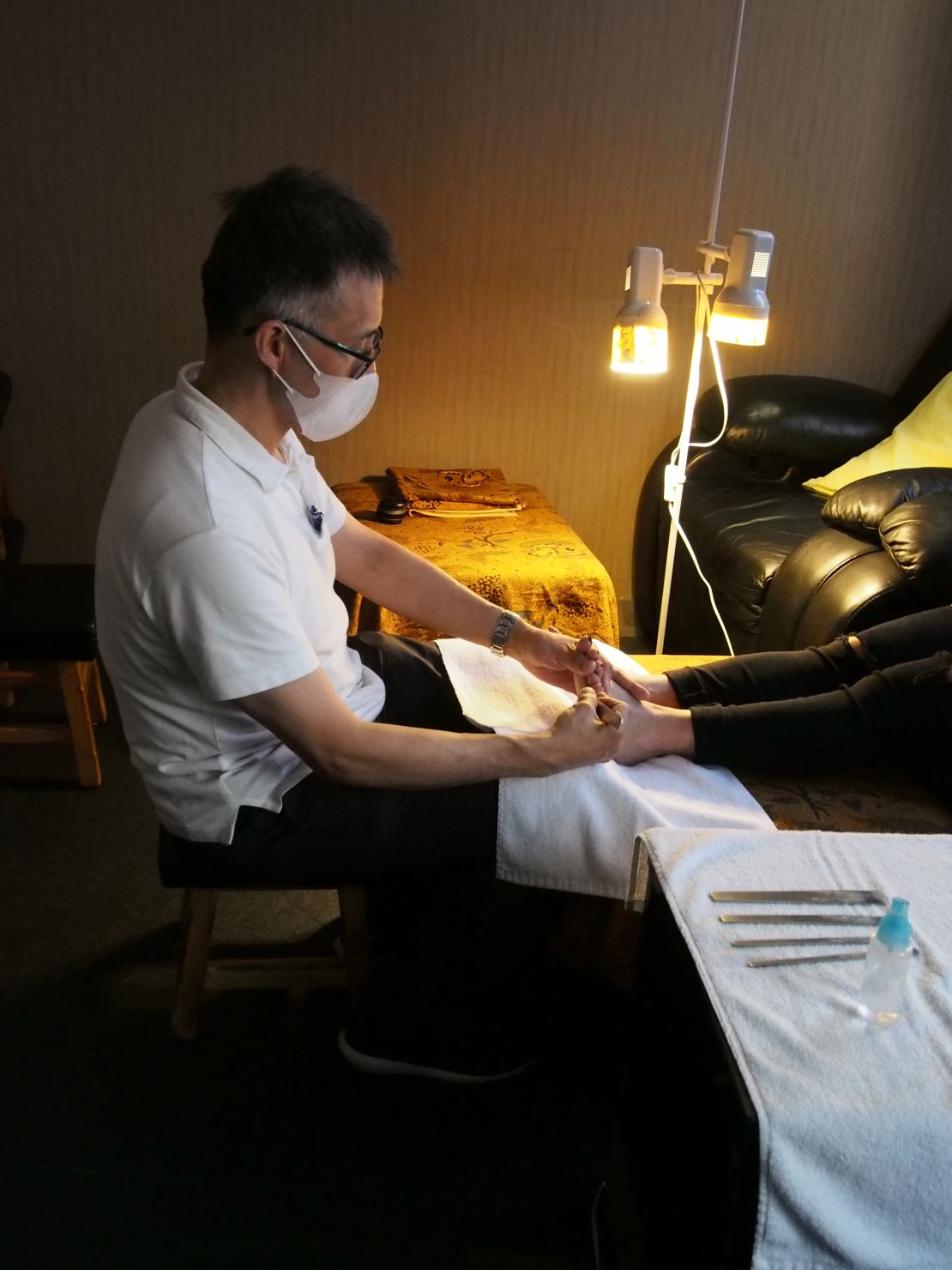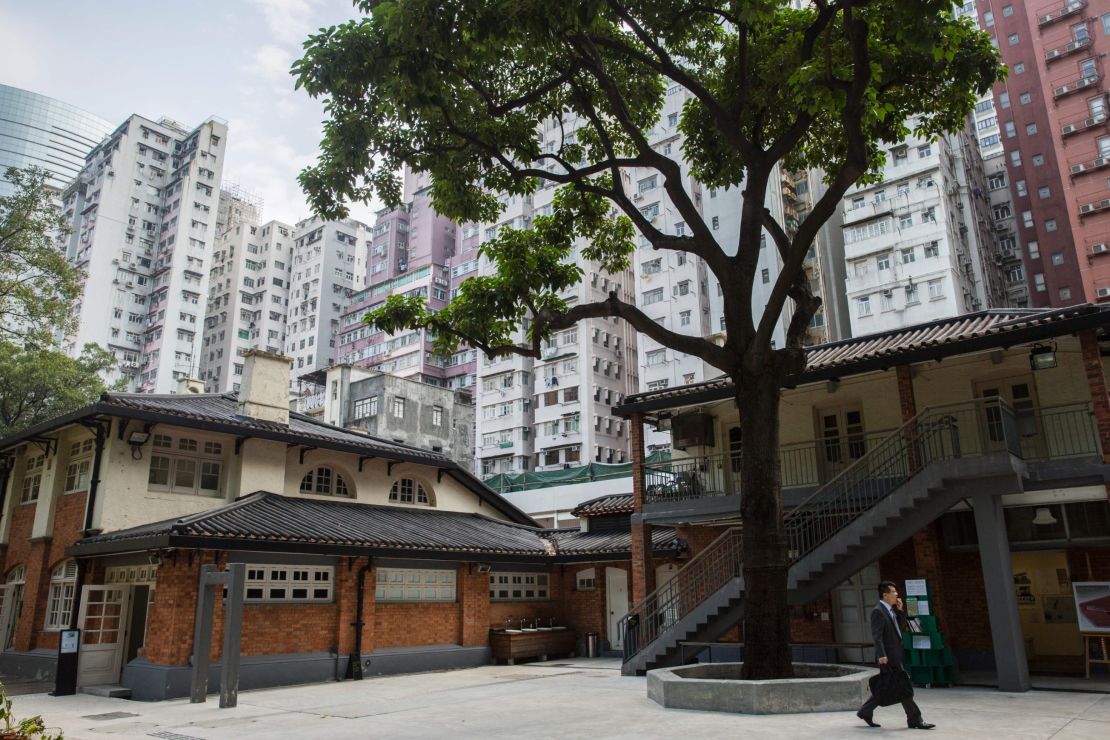As I sit down for a Shanghainese pedicure at the Mandarin Oriental Hong Kong, I quickly realize it’s not going to be the usual buff and polish.
Pedicurist Benjamin Cheung whips out a black satchel, full of blades in various shapes and sizes. And he plans to use them on my feet.
Cheung, who emigrated from Shanghai with his family in the 1990s, explains the centuries-old process: He’ll use his scalpels to shave off dead skin, clean up my cuticles and whittle down any calluses.
“In the old days, only wealthy people or businessmen got to enjoy Shanghainese pedicures. Most of the people could not afford these luxurious treatments,” Cheung tells CNN Travel.
“When (Shanghainese businessmen) moved to Hong Kong (in the 1900s), there was a demand for this service and that’s how Shanghainese pedicures were brought to this city. Now they are very common there and can be found in many public bathing facilities, spas and barbershops.”
A smooth shave

To begin the 50-minute treatment, Cheung runs a warm foot bath to soften the dry skin.
He then intently examines my feet, feeling each patch with his finger to gauge the roughness, before pulling out the appropriate tool.
“There are 10 blades in my tool kit. They don’t have English names but each of them with a different size and shape has different functions,” says Cheung.
“The big flat one can shave away hardened areas around the ankles and soles; the sharp thin one can get rid of ingrown toenails; and the one with a square head is a nail file.”
Without going into too much gory detail, Cheung smooths the balls of my feet, chisels through some calluses and delicately tidies my toenails.
I hardly felt anything while he was working, perhaps a tickle in places but certainly no pain. By the end, he’s used at least six blades and has carved what feels like two pounds off my heels.
Walking out of the salon, my soles are slippery smooth – it’s almost like gliding on two sticks of butter.
The sifu from Shanghai
But why a Shanghainese pedicure in Hong Kong?
“It’s worth keeping in mind that Shanghai and Hong Kong have had historic connections for almost two centuries,” John Carroll, a professor of history at the University of Hong Kong and the author of ” A Concise History of Hong Kong,” tells CNN Travel.
“Thousands of Shanghainese emigrated to Hong Kong over the years, usually during times of economic and political unrest in China. Why? There was opportunity here (in Hong Kong) and it was considered a safe place to go (as a British colony).”
In the 20th century, immigrants and refugees from Shanghai arrived in three major waves: after the Japanese invasion of China in 1937; during the Chinese Civil War from 1946 to 1949; and again in the 1950s after the Communist victory in 1949.
Nicknamed “Emigrant Entrepreneurs,” the Shanghainese brought businesses, expertise and sartorial style that still permeates Hong Kong culture today – evidenced by the remaining Shanghainese tailors, restaurants, barbers and, yes, pedicurists peppered about the city.
“When I was 11, my family moved to Hong Kong to explore opportunities, like many other families from China, in the ’80s and ‘90s,” Cheung tells CNN Travel.
“At the time, Hong Kong was well developed and there was a high demand for labor in different industries.”
As Cheung adjusted to the culture, he realized the value of having a niche professional skill that others couldn’t easily emulate.
“Shanghainese pedicures require special and traditional skills, which are passed down from generation to generation,” says Cheung.
“I was inspired by my uncle, who was a Shanghainese pedicurist, and decided to follow his path.”
At 18 years old, Cheung moved back to Shanghai where he studied the techniques for two years.
The young man returned to Hong Kong as a budding Shanghainese sifu (master) and took up the practice first at a private resort.
Cheung later joined the Mandarin Oriental in 2007, where he has worked for the past decade.
An urban trend
The Shanghainese pedicure was named after the Chinese city, but that’s most likely not where it originated.
Samuel So, another sifu who works at the Mandarin Oriental and apprenticed under Shanghainese masters, tells CNN that the pedicure was first practiced in rural areas and smaller cities, later making its way to Shanghai as the country urbanized.
Cities such as Yangzhou (northwest of Shanghai) were especially famous for bathhouse culture, thought to have caught on during the Song Dynasty (960-1279 AD).
“It was named the ‘Shanghainese’ pedicure because Shanghai was the place where everyone first learned about the treatment,” So tells CNN Travel.
“In the old days, many people wanted to move to Shanghai for a better job and a better life. Some people brought the pedicure skills with them to Shanghai.
“Like Hong Kong a few decades ago, Shanghai was a place with opportunities. The economy there was blooming, which led to high demands in grooming.”
In Hong Kong, the pedicures are thought to have first surfaced in the late 1940s with the opening of Shanghai Tong Hing Yuk Tak Bathhouse.
Emulating the traditional Shanghainese bathhouse culture, the Mong Kok address was a hotspot for socializing, business, entertainment and relaxation.
Though it closed in 2006, the bathhouse welcomed many high-profile customers – including actor Bruce Lee and a host of Cantonese opera stars – in its heyday.
Health before beauty
Over the years, Shanghainese pedicures have been adopted by day spas and foot reflexology centers in Hong Kong.
They’re a category all their own – considered more of a healthy practice than an aesthetic fix.
For starters, they traditionally don’t include nail polish, which makes them popular with both men and women.
But, more importantly, these foot treatments are considered to promote hygiene by shaving away dirt, ingrown toenails, corns, calluses and warts.
“In China, people do pedicures for practical reasons. They do of course improve the appearance of feet, but they also help your health,” says Cheung.
“Our feet support the weight of our whole body. If we suffer from foot problems, that could affect our walking and sitting postures, which may cause back and other health problems.”
Pedicures around town

Whether you’re treating yourself to a $100 pedicure at the Mandarin Oriental or sitting down for a more budget-friendly experience, travelers can find the traditional Chinese practice at various spas and foot massage halls throughout Hong Kong.
Among Hong Kong’s reputable addresses, travelers can experience the traditional treatment at Ten Feet Tall – a stylish address with spacious rooms, fresh juices and tropical decor.
Another option is Happy Foot – a well-known name around town with two locations, one in Central and another in Wan Chai. Both branches provide the service along with full-body massages, reflexology foot rubs and more.
Gao’s Foot Massage, tucked away in a commercial building in Central, also provides a clean environment and traditional Chinese decor.
Ten Feet Tall, 20-21/F, L Place, 139 Queen’s Rd Central, Hong Kong; +852 2971 1010
Happy Foot, 19/F, Century Square, 1 D’Aguilar St, Central; +852 2522 1151
Gao’s Foot Massage, 17/F, Silver Fortune Plaza, 1 Wellington St, Central, Hong Kong; +852 2810 9219
More Shanghai grooming

The influence of Shanghainese culture isn’t limited to pedicures. Across the city, you can still find remnants of traditional grooming in the form of barber shops and tailors.
“Shanghainese enjoyed nightlife, entertainment and a playful lifestyle,” Corey Mak, a researcher who authored “The Heritage of Hair-Cutting,” tells CNN Travel.
“All these places were run by Shanghainese (or Chinese who came to Hong Kong by way of Shanghai) with hopes of reproducing a cosmopolitan Shanghai atmosphere.”
Though many of the earlier venues have closed down over the years, travelers can still find a bit of Shanghai in Hong Kong – particularly in the North Point district, which became known as a “Little Shanghai.”
“Shanghainese barbers, in particular, had a reputation for providing modern and trendy services, not otherwise available locally,” explains Mak.
“Having ‘Shanghai Style’ on the signboard for a barbershop was a signal to potential customers that they’ll receive a high standard of service, a tidy environment and add-ons, such as cooling towels, shoe shining, cigarettes, scalp massages, and more.”
For a taste of Shanghai-style grooming, by way of Hong Kong, Mak points to old-school experts such as Shanghai Kiu Kwun Barber Shop (74 Java Rd, North Point) and Shanghai Laido Barber Shop (23 Yin Hing St, San Po Kong) or Shanghai Sun Ngah Monalisa Hair Salon (457 Reclamation St, Mong Kok).
“Currently many of these extra services have been dropped,” says Mak. “But Shanghainese barbers still have a reputation for being clean-cut – intended to instill in their customers a desire to follow suit.”









